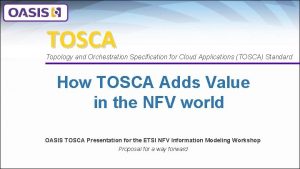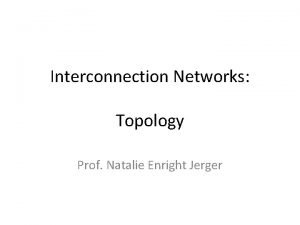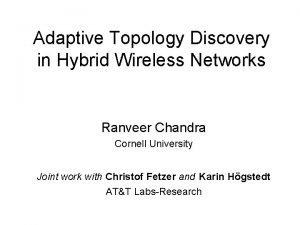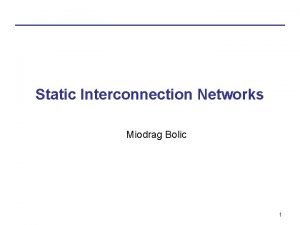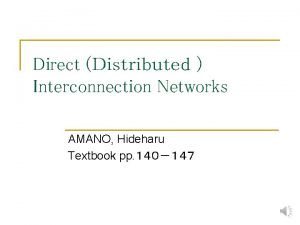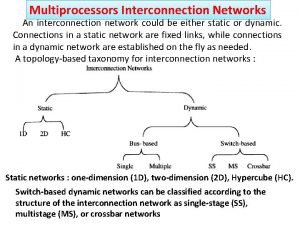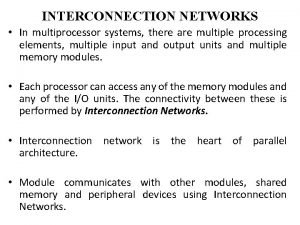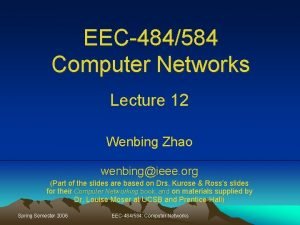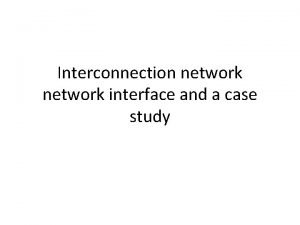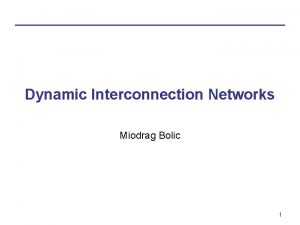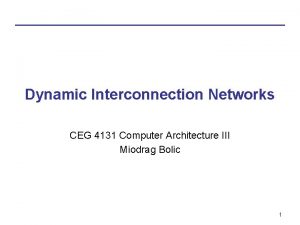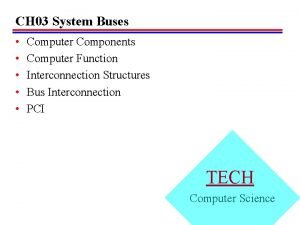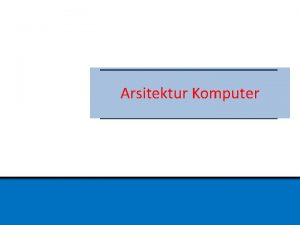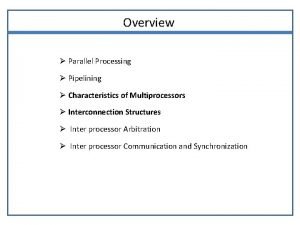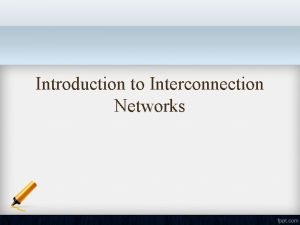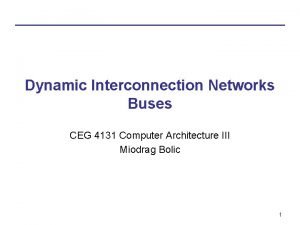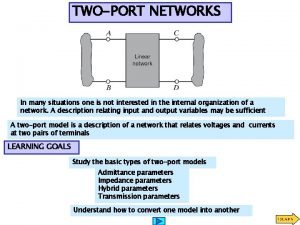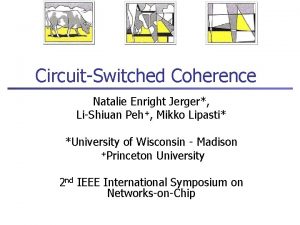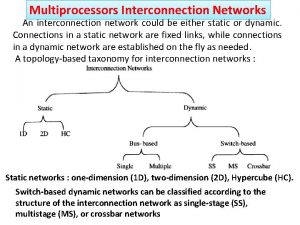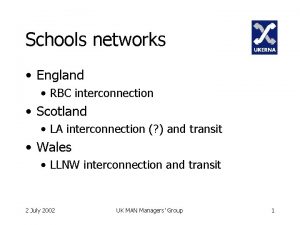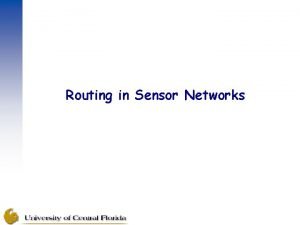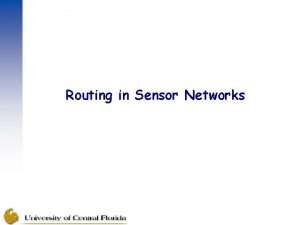Interconnection Networks Routing Prof Natalie Enright Jerger Routing






































- Slides: 38

Interconnection Networks: Routing Prof. Natalie Enright Jerger

Routing Overview • Discussion of topologies assumed ideal routing • In practice… – Routing algorithms are not ideal • Goal: distribute traffic evenly among paths – Avoid hot spots, contention – More balanced closer throughput is to ideal • Keep complexity in mind Fall 2014 ECE 1749 H: Interconnection Networks (Enright Jerger) 2

Routing Basics • Once topology is fixed • Routing algorithm determines path(s) from source to destination Fall 2014 ECE 1749 H: Interconnection Networks (Enright Jerger) 3

Routing Example 0 1 2 3 4 5 6 7 • Some routing options: – Greedy: shortest path – Uniform random: randomly pick direction – Adaptive: send packet in direction with lowest local channel load • Which gives best worst-case throughput? Fall 2014 ECE 1749 H: Interconnection Networks (Enright Jerger) 4

Routing Example (2) 0 1 2 3 4 5 6 7 • Consider tornado traffic – node i sends to i+3 mod 8 Fall 2014 ECE 1749 H: Interconnection Networks (Enright Jerger) 5

Routing Example (3) • Greedy: – All traffic moves counterclockwise • Loads counterclockwise with 3 units of traffic – Each node gets 1/3 throughput • Clockwise channels are idle • Random: – Clockwise channels become bottleneck • Load of 5/2 – Half of traffic traverses 5 links in clockwise direction – Gives throughput of 2/5 Fall 2014 ECE 1749 H: Interconnection Networks (Enright Jerger) 6

Routing Example (4) • Adaptive: – Perfect load balancing (some assumptions about implementation) – Sends 5/8 of traffic over 3 links, sends 3/8 over 5 links • Channel load is 15/8, throughput of 8/15 • Note: worst case throughput just 1 metric designer might optimize Fall 2014 ECE 1749 H: Interconnection Networks (Enright Jerger) 7

Routing Algorithm Attributes • Types – Deterministic, Oblivious, Adaptive • Number of destinations – Unicast, Multicast, Broadcast? • Adaptivity – Oblivious or Adaptive? Local or Global knowledge? – Minimal or non-minimal? • Implementation – Source or node routing? – Table or circuit? Fall 2014 ECE 1749 H: Interconnection Networks (Enright Jerger) 8

Routing Deadlock A B D C • Each packet is occupying a link and waiting for a link • Without routing restrictions, a resource cycle can occur – Leads to deadlock Fall 2014 ECE 1749 H: Interconnection Networks (Enright Jerger) 9

Deterministic • All messages from Source to Destination traverse the same path • Common example: Dimension Order Routing (DOR) – Message traverses network dimension by dimension – Aka XY routing • Cons: – Eliminates any path diversity provided by topology – Poor load balancing • Pros: – Simple and inexpensive to implement – Deadlock-free Fall 2014 ECE 1749 H: Interconnection Networks (Enright Jerger) 10

Dimension Order Routing: Cube networks • a. k. a X-Y Routing – Traverse network dimension by dimension – Can only turn to Y dimension after finished X Fall 2014 ECE 1749 H: Interconnection Networks (Enright Jerger) 11

Destination-Tag Routing: Butterfly Networks • Destination address – Interpreted as an ndigit radix-k number – Directly routes packet • Each digit selects the output port at each step Fall 2014 0 1 2 3 4 5 6 7 1 00 10 20 01 02 03 ECE 1749 H: Interconnection Networks (Enright Jerger) 11 12 13 21 22 23 0 1 2 3 4 5 6 7 2 -ary 3 -fly 12

Oblivious • Routing decisions are made without regard to network state – Keeps algorithms simple – Unable to adapt • Deterministic algorithms are a subset of oblivious Fall 2014 ECE 1749 H: Interconnection Networks (Enright Jerger) 13

Valiant’s Routing Algorithm • To route from s to d – Randomly choose intermediate node d’ – Route from s to d’ and from d’ to d. d’ • Randomizes any traffic pattern – All patterns appear uniform random – Balances network load • Non-minimal • Destroys locality Fall 2014 d s ECE 1749 H: Interconnection Networks (Enright Jerger) 14

Minimal Oblivious • Valiant’s: Load balancing but significant increase in hop count • Minimal Oblivious: some load balancing, but use shortest paths – d’ must lie within min quadrant – 6 options for d’ – Only 3 different paths Fall 2014 d s ECE 1749 H: Interconnection Networks (Enright Jerger) 15

Minimal Oblivious Routing on Fat Tree • Node labels (addr template) – All nodes reachable from left terminals • Route from s to d – Randomly selected, nearest common ancestor x of s and d • Route s to x then x to d • Example s = 1, d = 6 • Construct route incrementally – Randomly select output port – Until addr template matches d Fall 2014 0 1 000 X 2 3 001 X 4 5 010 X 6 7 011 X 8 9 100 X A B 101 X C D 110 X E F 111 X 00 XX 0 XXX A XXXX A 01 XX 0 XXX B XXXX B 10 XX 1 XXX A XXXX C 11 XX 1 XXX B XXXX D ECE 1749 H: Interconnection Networks (Enright Jerger) 16

Oblivious Routing • Valiant’s and Minimal Oblivious – Deadlock free • When used in conjunction with X-Y routing • Randomly choose between X-Y and Y-X routes – Oblivious but not deadlock free! Fall 2014 ECE 1749 H: Interconnection Networks (Enright Jerger) 17

Adaptive • Exploits path diversity • Uses network state to make routing decisions – Buffer occupancies often used – Coupled with flow control mechanism • Local information readily available – Global information more costly to obtain – Network state can change rapidly – Use of local information can lead to non-optimal choices • Can be minimal or non-minimal Fall 2014 ECE 1749 H: Interconnection Networks (Enright Jerger) 18

Minimal Adaptive Routing d s • Local info can result in sub-optimal choices Fall 2014 ECE 1749 H: Interconnection Networks (Enright Jerger) 19

Non-minimal adaptive • Fully adaptive • Not restricted to take shortest path • Misrouting: directing packet along non-productive channel – Priority given to productive output – Some algorithms forbid U-turns • Livelock potential: traversing network without ever reaching destination – Mechanism to guarantee forward progress • Limit number of misroutings Fall 2014 ECE 1749 H: Interconnection Networks (Enright Jerger) 20

Non-minimal routing example d d s s • Longer path with potentially lower latency • Livelock: continue routing in cycle Fall 2014 ECE 1749 H: Interconnection Networks (Enright Jerger) 21

Adaptive Routing Example 0 1 2 3 4 5 6 7 • Should 3 route clockwise or counterclockwise to 7? – 5 is using all the capacity of link 5 6 • Queue at node 5 will sense contention but not at node 3 • Backpressure: allows nodes to indirectly sense congestion – Queue in one node fills up, it will stop receiving flits – Previous queue will fill up • If each queue holds 4 packets – 3 will send 8 packets before sensing congestion Fall 2014 ECE 1749 H: Interconnection Networks (Enright Jerger) 22

Congestion Information • Local – Information about my neighbors only – Implicitly available – I know how many downstream buffers are available (from flow control) • Global – Information about all nodes – Explicitly send status information – Usually based on VC utilization or buffer occupancy • Timeliness Fall 2014 ECE 1749 H: Interconnection Networks (Enright Jerger) 23

Sending Congestion Information • Piggybacking – Send congestion information along with packets • Extra side network – More affordable in on-chip networks – Broadcast – Packetize • Aggregate or individual node Fall 2014 ECE 1749 H: Interconnection Networks (Enright Jerger) 24

Partially Adaptive Routing: Turn Model • DOR eliminates 4 turns – N to E, N to W, S to E, S to W – No adaptivity • Some adaptivity by removing 2 of 8 turns – Remains deadlock free (like DOR) • West first – Eliminates S to W and N to W Fall 2014 West first ECE 1749 H: Interconnection Networks (Enright Jerger) 25

Turn Model Routing Negative first • Negative first North last – Eliminates E to S and N to W • North last – Eliminates N to E and N to W • Odd-Even – Eliminates 2 turns depending on if current node is in odd of even column • Even column: E to N and N to W • Odd column: E to S and S to W – Deadlock free (disallow 180 turns) – Better adaptivity Fall 2014 ECE 1749 H: Interconnection Networks (Enright Jerger) 26

Negative-First Routing Example (2, 3) (0, 3) (2, 0) (0, 0) • Limited or no adaptivity for certain sourcedestination pairs Fall 2014 ECE 1749 H: Interconnection Networks (Enright Jerger) 27

Turn Model Routing Deadlock • What about eliminating turns NW and WN? • Not a valid turn elimination – Resource cycle results Fall 2014 ECE 1749 H: Interconnection Networks (Enright Jerger) 28

Adaptive Routing and Deadlock • Option 1: Eliminate turns that lead to deadlock – Limits flexibility • Option 2: Allow all turns – Give more flexibility – Must use other mechanism to prevent deadlock – Rely on flow control (later) • Escape virtual channels Fall 2014 ECE 1749 H: Interconnection Networks (Enright Jerger) 29

Adaptive Routing: Other Topologies • Butterfly: no path diversity – Can add extra stages for path diversity, adaptive routing • Fat tree (folded Clos) – Similar to minimal oblivious • But instead of randomly selecting path to least common ancestor – Select adaptively (upstream) – Message routed deterministically (downstream) Fall 2014 ECE 1749 H: Interconnection Networks (Enright Jerger) 30

Routing Implementation • Source tables – Entire route specified at source – Avoids per-hop routing latency – Unable to adapt dynamically to network conditions – Can specify multiple routes per destination • Give fault tolerance and load balance – Support reconfiguration (not specific to topology) Fall 2014 ECE 1749 H: Interconnection Networks (Enright Jerger) 31

Source Table Routing Destination Route 1 Route 2 00 X X 10 EX EX 20 EEX 01 NX NX 11 NEX ENX 21 NEEX ENEX 02 NNX 12 ENNX NNEX 22 EENNX NNEEX 03 NNNX 13 NENNX ENNNX 23 EENNNX NNNEEX (0, 0) • Arbitrary length paths: storage overhead and packet overhead Fall 2014 ECE 1749 H: Interconnection Networks (Enright Jerger) 32

Node Tables • Store only next direction at each node • Smaller tables than source routing • Adds per-hop routing latency • Can adapt to network conditions – Specify multiple possible outputs per destination – Select randomly to improve load balancing Fall 2014 ECE 1749 H: Interconnection Networks (Enright Jerger) 33

Node Table Routing To From 00 01 02 10 11 12 20 21 22 00 X |- N | - N|- E|N E|- E|N 01 S|- X|- N|- E|S 02 S | - S| - X|- E|S 10 W|- W|- X|- N|- 11 W|- W|- S|- X|- N|- E|S 12 W|- W|- S|- X|- E|S 20 W|- W|- W|- X|- N|- 21 W|- W|- W|- S|- X|- N|- 22 W|- W|- W|- S|- X|- E|- E|N E|S E|S E|- E|N E|- (1, 0) • Implements West-First Routing • Each node would have 1 row of table – Max two possible output ports Fall 2014 ECE 1749 H: Interconnection Networks (Enright Jerger) 34

Implementation • Combinational circuits can be used – Simple (e. g. DOR): low router overhead – Specific to one topology and one routing algorithm • Limits fault tolerance • Tables can be updated to reflect new configuration, network faults, etc Fall 2014 ECE 1749 H: Interconnection Networks (Enright Jerger) 35

Circuit Based x sy Queue lengths +y =0 -y +y -x +x Route selection exit Selected Direction Vector -x +x Productive Direction Vector exit =0 y -y sx • Next hop based on buffer occupancies • Or could implement simple DOR • Fixed w. r. t. topology Fall 2014 ECE 1749 H: Interconnection Networks (Enright Jerger) 36

Routing Algorithms: Implementation Routing Algorithm Source Routing Combinational Node Table Deterministic DOR Yes Yes Oblivious Valiant’s Minimal Adaptive Yes No Yes Yes Yes Fall 2014 ECE 1749 H: Interconnection Networks (Enright Jerger) 37

Routing Summary • Latency paramount concern – Minimal routing most common for No. C – Non-minimal can avoid congestion and deliver low latency • To date: No. C research favors DOR for simplicity and deadlock freedom – On-chip networks often lightly loaded • Only covered unicast routing – Recent work on extending on-chip routing to support multicast Fall 2014 ECE 1749 H: Interconnection Networks (Enright Jerger) 38
 Natalie enright jerger
Natalie enright jerger Tosca orchestration
Tosca orchestration Natalie dana enright jerger
Natalie dana enright jerger Natalie enright jerger
Natalie enright jerger Natalie enright jerger
Natalie enright jerger Natalie enright jerger
Natalie enright jerger Natalie enright jerger
Natalie enright jerger Static interconnection networks
Static interconnection networks Direct interconnection networks
Direct interconnection networks Dynamic interconnection network in computer architecture
Dynamic interconnection network in computer architecture Interconnection networks in multiprocessor systems
Interconnection networks in multiprocessor systems Aisling enright
Aisling enright Ecuacion de enright
Ecuacion de enright Dr robert enright
Dr robert enright Christina enright
Christina enright Reservoir routing example
Reservoir routing example Mark tinka
Mark tinka Hydrologic continuity equation
Hydrologic continuity equation Power routing in vlsi
Power routing in vlsi Algorithms in computer networks
Algorithms in computer networks Broadcast routing in computer networks
Broadcast routing in computer networks Datagram networks
Datagram networks Backbone networks in computer networks
Backbone networks in computer networks Network interconnection studies
Network interconnection studies Osi model definition
Osi model definition Sequential interrupt processing
Sequential interrupt processing Business registers interconnection system (bris)
Business registers interconnection system (bris) Vincent dijkstra
Vincent dijkstra Chordal ring
Chordal ring Bratislav milanovic
Bratislav milanovic Open system interconnection
Open system interconnection Dynamic interconnection network in computer architecture
Dynamic interconnection network in computer architecture Function of the control unit
Function of the control unit Jenis-jenis bus komputer
Jenis-jenis bus komputer Characteristics of multiprocessor system
Characteristics of multiprocessor system Characteristics of vector processing
Characteristics of vector processing Network interconnection studies
Network interconnection studies Bus interconnection in computer architecture
Bus interconnection in computer architecture Two ports containing no sources then
Two ports containing no sources then

